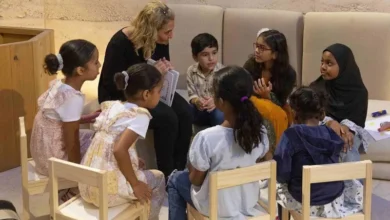Teens in UAE vape to deal with the stress of school, doctors warn

Doctors in the UAE are seeing children as young as 14 come to hospital emergency rooms with complaints like chronic cough, chest pain, and breathlessness. Reason: E-cigarette smoking.
Some picked up the habit thinking it would help them alleviate the stress of studies. Dr Emadeldin Ibrahim, consultant pulmonologist at Medcare Hospital Sharjah, told Khaleej Times that a boy he treated started smoking when he was 14 to cope with schoolwork.
When he arrived at the hospital, he was wheezing nonstop, “exhibiting many of the classic signs and symptoms of recurrent bronchitis and asthma”.
“I asked him about e-cigarettes because there was no family history of asthma and the findings of the lab and radiography were all normal. He admitted to smoking them,” said Dr Emadeldin.
The doctor made the boy quit smoking, but his asthma would require at least three months of medication.
A new report by the World Health Organisation (WHO) found that 37 million children aged 13-15 years use tobacco globally. Of these, the rate of e-cigarette use among adolescents exceeds that of adults in many countries as the “tobacco industry tries to sell the same nicotine to our children in different packaging”, according to WHO director-general Dr Tedros Adhanom Ghebreyesus.
Talking to Khaleej Times, an expert highlighted the case of a 15-year-old with a history of asthma. The boy picked up e-cigarette smoking as he was intrigued by its “appealing flavours”.
Dr Mohamed Saifeldin Abdelrahaman Mohamed, specialist pulmonologist at Thumbay University Hospital, said the boy experienced lethargy, headaches, and dizziness. In addition, he had a low oxygen saturation level, an increased heart rate, and respiratory distress.
“His lungs were crackling and wheezing, which would indicate inflammation and infection. He was diagnosed with acute eosinophilic pneumonia — a severe inflammatory condition of the lungs often linked to inhalation of harmful substances — which, in his case, was associated with e-cigarette use.”
The boy had to undergo a week of “rigorous therapy” after his health stabilised and his lung function started to get better. “He was given a stern no-smoking order, which included e-cigarettes, and was told to have frequent follow-up visits with a pulmonologist,” said Dr Mohamed.
Targeting the youth
The WHO report detailed how e-cigarette producers make their products more appealing to children: Use designs that resemble toys and cartoon characters, and incorporate sleek, high-tech features in limited editions.
“Many e-cigarettes are also designed to allow discreet use and are marketed as such. Some can be integrated into hoodies or resemble pens, lipsticks or watches, so they can be hidden, especially from teachers and parents, and used in places where smoking or e-cigarette use is not permitted,” said the report titled ‘Hooking the next generation: how the tobacco industry captures young customers’.
UAE-based experts said majority of young smokers use e-cigarettes because of the appealing smells and flavours. This is consistent with what the WHO found. Citing research from the US, the WHO said 70 per cent of youth e-cigarette users would quit if the products were only available in tobacco flavours.
“The attractive shapes and designs, sometimes resembling toys or tech gadgets, make them particularly enticing (for youngsters),” said Dr Mohamed.
Dr Emadeldin said that unlike traditional cigarettes, e-cigarettes have no distinct odour, “making it much easier for children to use them surreptitiously”.
“The kid-friendly packaging and flavours make smoking appear fun, so even kids who have never attempted cigarettes may be persuaded to try them,” said the doctor.
Safer than cigarettes?
E-cigarette producers promote their products as being “safer” than cigarettes.
“While long-term health effects are not fully understood, it has been established that they generate toxic substances, some of which are known to cause cancer and some that increase the risk of heart and lung disorders. Use of e-cigarettes can also affect brain development, potentially leading to learning and anxiety disorders for young people,” the WHO report said.
Dr Mohamed said many children use e-cigarettes because of the perception that they are safer. However, children he has seen have even coughed up blood.
“Often, children initially conceal their e-cigarette use, making it challenging to diagnose accurately. Through invasive investigations, we often discover that their vaping habits have significantly impacted their lung health. E-cigarettes can cause prolonged cough lasting more than one to two months and create an environment in the lungs that predisposes them to severe respiratory issues. These conditions are serious and require intensive treatment to manage and resolve.”
According to Dr Emadeldin, unexplained chest pains are the most common health ailment he sees in young children. Any time he sees young patients complain of this, he immediately advises them to quit using e-cigarettes.
“E-cigarettes not only make one susceptible to asthma and bronchitis, I’ve seen younger people being diagnosed with pneumonia and unusual infections that are resistant to standard medications (antibiotics) and that require prolonged therapy of up to two weeks.”
Have open conversations
Parents and schools play a “crucial role” in preventing children from smoking.
“It’s a myth that children won’t listen to adults about the dangers of e-cigarettes. Open, honest conversations about the health risks are essential. Parents should set a good example by avoiding smoking themselves, and schools should incorporate comprehensive education on the harms of e-cigarettes into their health curriculums,” said Dr Mohamed.
Dr Emadeldin advised guardians to discuss the risks associated with smoking and vaping, both short- and long-term.










